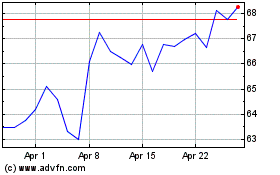Hoping to Find Gold, Rio Tinto Strikes Lithium Instead
October 22 2019 - 3:05AM
Dow Jones News
By Rhiannon Hoyle
SYDNEY-- Rio Tinto PLC thinks it can become the biggest domestic
producer of lithium in the U.S. without digging a new hole in the
ground.
Rio Tinto plans to process piles of waste rock with chemicals at
its operation at Boron in the Californian desert in a bet that they
contain vast stores of lithium, a sought-after mineral that helps
to power the world's electric-vehicle fleet. A test plant is under
construction at the 90-year-old mine that has thrived on production
of a different commodity--borates--until now.
Global miners are tapping waste pits for minerals as a way to
squeeze extra profits from their existing operations quickly. New
technology has made such efforts easier. Many commodities in waste
dumps have gone from worthless to priceless, often in a matter of
years, as prices boom.
Morgan Stanley predicts demand for lithium carbonate will
roughly triple by 2025 from 2017 levels, driven by the growing
popularity of electric vehicles. U.S. authorities also worry about
future supply, with the Department of the Interior last year naming
lithium among 35 mineral commodities that it considers critical to
U.S. economic and national security.
For Rio Tinto, lithium wasn't the main target when it began
sifting through the waste rock at Boron for overlooked minerals. It
had hoped to find quantities of gold.
"Our team had a eureka moment when they did some testing to look
for valuable minerals beyond boron in our waste rock and found high
grades of lithium," said Bold Baatar, Rio Tinto's energy and
minerals chief executive.
Currently the only lithium-carbonate production in the U.S.
comes from Albemarle Corp.'s Silver Peak operation in Nevada,
according to the U.S. Geological Survey. Yet preliminary tests
showed some of the waste rock at Boron contained higher grades of
lithium than several deposits in the U.S. currently being assessed
for new mines.
"If the trials continue to prove successful, this has the
potential to become America's largest domestic producer of
battery-grade lithium--all without the need for further mining,"
Mr. Baatar said.
Rio Tinto said it plans to spend $10 million assembling the
pilot plant, which will be able to produce 10 metric tons of
lithium-carbonate equivalent annually, or enough for 30 Tesla Model
S batteries. If it works, Rio Tinto could invest in a $50 million
industrial-scale plant to produce 5,000 tons a year, or enough for
around 15,000 batteries.
The Boron operation produces roughly half the world's supply of
refined borate products, according to Rio Tinto. Borates are used
in everything from fertilizers to cellphones to soap.
At a time when mining companies are under pressure for their
environmental footprint, Rio Tinto said it expects production using
waste rock at Boron will require less energy than new mines.
Australia and Chile accounted for most of the world's output of
lithium last year, according to U.S. Geological Survey.
The Boron project isn't Rio Tinto's only bet on sustained demand
for lithium. Management is separately assessing whether to build a
mine at its Jadar lithium-borate deposit in Serbia.
Write to Rhiannon Hoyle at rhiannon.hoyle@wsj.com
(END) Dow Jones Newswires
October 22, 2019 02:50 ET (06:50 GMT)
Copyright (c) 2019 Dow Jones & Company, Inc.
Rio Tinto (NYSE:RIO)
Historical Stock Chart
From Mar 2024 to Apr 2024

Rio Tinto (NYSE:RIO)
Historical Stock Chart
From Apr 2023 to Apr 2024
